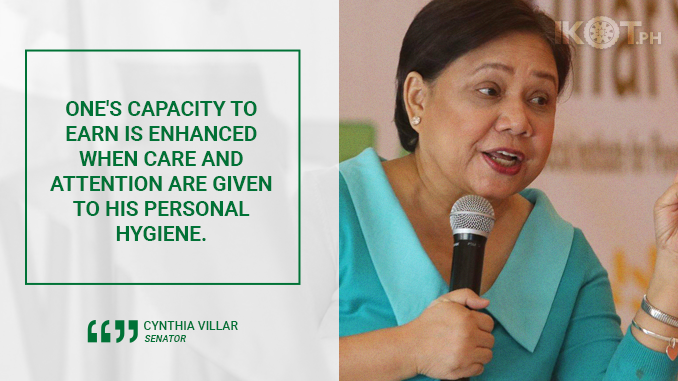Senator Cynthia Villar filed a resolution directing the Senate to conduct an inquiry into the waste water treatment and sewerage system in Metro Manila, which was identified as a main factor in the continued deterioration of the quality of water in Manila Bay.
“We still have a long way to go in reviving Manila Bay back to its pristine condition. Sadly, despite our efforts to clean up, water quality in the bay continues to worsen because of poor solid waste management and the lack of facilities for proper waste water disposal,” Villar said.
The veteran legislator, chairperson of the Committee on Environment and Natural Resources, filed Proposed Senate Resolution No. 747, directing an inquiry into the condition of waste water treatment in Metro Manila.
During the Senate hearing reviewing the measures and strategies taken by 13 government agencies mandated by the Supreme Court to lead the clean up of Manila Bay, environmental lawyer Antonio Oposa has referred to Manila Bay as a toilet bowl used everyday but never gets flushed.
Environmental lawyer Antonio Oposa has referred to Manila Bay as a toilet bowl used everyday but never gets flushed.
The seasoned lawmaker also pointed to the existence of informal settlers in the Port of Manila, which do not have toilet facilities. This was also the reason why she initiated a project with the Department of Health (DOH) to provide toilet bowls in Baseco, where 5,000 families have no toilets.
“Despite the mandate given to MWSS way back in 1971 and the responsibilities given to its concessionaires more than 20 years ago, Metro Manila is still far from having adequate sewerage facilities, which is an indication that there is a failure of implementation and enforcement of the laws with respect to the provision of adequate sanitation, drainage and sewerage facilities even in Metro Manila; and this amounts to a violation of the “right of the people to a balanced and healthful ecology” as the people’s health continues to be in peril,” part of the resolution said.
In filing the resolution, the lady senator noted that a number of statutes mandate national and local government agencies and instrumentalities, as well as private entities to protect the environment, including the management of waste water.
As early as the 1970s, Presidential Decree No. 1152 or the Philippine Environmental Code, government agencies were already given the task of managing the waste water being discharged to the surrounding environment.
Under PD No. 856 or the Code on Sanitation of the Philippines in 1975, the Department of Health was given the task to ensure that adequate sewerage systems are installed in private and public establishments.
Further, Republic Act 7160 or the Local Government Code of 1991 gave to all municipalities, cities, and provinces the responsibility of providing drainage and sewerage facilities within their respective jurisdictions.
Lastly, RA 9275 or the Philippine Clean Water Act of 2004 designated the Department of Environment and Natural Resources as the lead agency which will exercise supervision and control over all aspects of water quality management. The same law gave the Department of Public Works and Highways the task of preparing a National Sewerage and Septage Management Program.
Section 8 of RA 9275 provides that the agency vested to provide water supply and sewerage facilities and/or concessionaires in Metro Manila and other highly urbanized cities to connect the existing sewage line found in all subdivisions, condominiums, commercial centers, hotels, sports and recreational facilities, hospitals, market places, public buildings, industrial complex and other similar establishments including households to available sewerage system.
The chief regulator of MWSS has stated that the lack of sewerage facilities in Metro Manila is “ten times worse” than Boracay as Manila “has only 14 percent of its required number of sewerage treatment plants, which remove contaminants from the wastewater before it is dumped in rivers and bays.”
The chief regulator of MWSS has stated that the lack of sewerage facilities in Metro Manila is “ten times worse” than Boracay as Manila “has only 14 percent of its required number of sewerage treatment plants.
“We want to know what the MWSS and its concessionaires are doing or planning to do to speed up the pace of the installation of sewerage treatment plants in Metro Manila because the next 19 years may be too long and would make the problem irreversible,” Villar said.
The resolution also seeks to determine whether or not the concessionaires are actually collecting and using the water utility charges, including the environmental and sewerage charges, from their respective consumers in order to fund the concessionaires’ sewerage projects.

